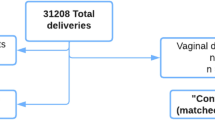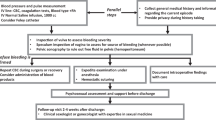Abstract
Objective:
To identify risk factors for severe (third/fourth degree) perineal laceration with operative vaginal delivery (OVD, forceps or vacuum).
Study Design:
Case-control study comparing singleton OVDs with or without severe laceration (n=138).
Result:
In multivariable analyses, severe perineal laceration was associated with occiput posterior (OP) position at delivery, vaginal nulliparity, use of forceps, longer period pushing in the second stage and lower gestational age, but not birth weight, labor induction or episiotomy. Among 29 OP patients at full dilation, 9/13 (69%) attempted rotations to occiput anterior (OA) were successful, and 14/16 (88%) patients in whom rotation was not attempted remained OP at delivery. Successful rotation from OP to OA was associated with fewer severe lacerations than no attempt or unsuccessful rotation (22 vs 75%, P=0.01).
Conclusion:
Severe perineal laceration during OVD is associated with OP position at delivery and is reduced threefold in patients successfully rotated from OP to OA.
This is a preview of subscription content, access via your institution
Access options
Subscribe to this journal
Receive 12 print issues and online access
$259.00 per year
only $21.58 per issue
Buy this article
- Purchase on Springer Link
- Instant access to full article PDF
Prices may be subject to local taxes which are calculated during checkout
Similar content being viewed by others
References
Hordnes K, Bergsjo P . Severe lacerations after childbirth. Acta Obstet Gynecol Scand 1993; 72 (6): 413–422.
Borello-France D, Burgio KL, Richter HE, Zyczynski H, Fitzgerald MP, Whitehead W et al. Fecal and urinary incontinence in primiparous women. Obstet Gynecol. 2006; 108 (4): 863–872.
Bofill JA, Rust OA, Schorr SJ, Brown RC, Martin RW, Martin JN Jr et al. A randomized prospective trial of the obstetric forceps versus the M-cup vacuum extractor. Am J Obstet Gynecol. 1996; 175 (5): 1325–1330.
Caughey AB, Sandberg PL, Zlatnik MG, Thiet MP, Parer JT, Laros RK Jr . Forceps compared with vacuum: rates of neonatal and maternal morbidity. Obstet Gynecol. 2005; 106 (5 Pt 1): 908–912.
Damron DP, Capeless EL . Operative vaginal delivery: a comparison of forceps and vacuum for success rate and risk of rectal sphincter injury. Am J Obstet Gynecol. 2004; 191 (3): 907–910.
Dandolu V, Chatwani A, Harmanli O, Floro C, Gaughan JP, Hernandez E . Risk factors for obstetrical anal sphincter lacerations. Int Urogynecol J Pelvic Floor Dysfunct 2005; 16 (4): 304–307.
Landy HJ, Laughon SK, Bailit JL, Kominiarek MA, Gonzalez-Quintero VH, Ramirez M et al. Characteristics associated with severe perineal and cervical lacerations during vaginal delivery. Obstet Gynecol 2011; 117 (3): 627–635.
Benavides L, Wu JM, Hundley AF, Ivester TS, Visco AG . The impact of occiput posterior fetal head position on the risk of anal sphincter injury in forceps-assisted vaginal deliveries. Am J Obstet Gynecol. 2005; 192 (5): 1702–1706.
Senecal J, Xiong X, Fraser WD . Effect of fetal position on second-stage duration and labor outcome. Obstet Gynecol 2005; 105 (4): 763–772.
Wu JM, Williams KS, Hundley AF, Connolly A, Visco AG . Occiput posterior fetal head position increases the risk of anal sphincter injury in vacuum-assisted deliveries. Am J Obstet Gynecol. 2005; 193 (2) 525–528.
Bradley MS, Kaminski RJ, Streitman DC, Dunn SL, Krans EE . Effect of rotation on perineal lacerations in forceps-assisted vaginal deliveries. Obstet Gynecol 2013; 122 (1): 132–137.
Hankins GD, Leicht T, Van Hook J, Uckan EM . The role of forceps rotation in maternal and neonatal injury. Am J Obstet Gynecol 1999; 180 (1 Pt 1): 231–234.
Le Ray C, Deneux-Tharaux C, Khireddine I, Dreyfus M, Vardon D, Goffinet F . Manual rotation to decrease operative delivery in posterior or transverse positions. Obstet Gynecol 2013; 122 (3): 634–640.
Le Ray C, Serres P, Schmitz T, Cabrol D, Goffinet F . Manual rotation in occiput posterior or transverse positions: risk factors and consequences on the cesarean delivery rate. Obstet Gynecol 2007; 110 (4): 873–879.
Reichman O, Gdansky E, Latinsky B, Labi S, Samueloff A . Digital rotation from occipito-posterior to occipito-anterior decreases the need for cesarean section. Eur J Obstet Gynecol Reprod Biol 2008; 136 (1): 25–28.
Shaffer BL, Cheng YW, Vargas JE, Caughey AB . Manual rotation to reduce caesarean delivery in persistent occiput posterior or transverse position. J Matern Fetal Neonatal Med 2011; 24 (1): 65–72.
Stock SJ, Josephs K, Farquharson S, Love C, Cooper SE, Kissack C et al. Maternal and neonatal outcomes of successful Kielland's rotational forceps delivery. Obstet Gynecol 2013; 121 (5): 1032–1039.
Norwitz ER Robinson JN Repke JT . Labor and delivery. In: Gabbe SG, Niebyl JR, Simpson JL (eds). Obstetrics: Normal and Problem Pregnancies. Philadelphia, PA, USA: Churchill Lovingstone, 2002, pp 353–394.
Author information
Authors and Affiliations
Corresponding author
Ethics declarations
Competing interests
The authors declare no conflict of interest.
Rights and permissions
About this article
Cite this article
Hirsch, E., Elue, R., Wagner, A. et al. Severe perineal laceration during operative vaginal delivery: the impact of occiput posterior position. J Perinatol 34, 898–900 (2014). https://doi.org/10.1038/jp.2014.103
Received:
Revised:
Accepted:
Published:
Issue Date:
DOI: https://doi.org/10.1038/jp.2014.103
This article is cited by
-
Temporal decline in the improved detection rates following OASIS workshops
International Urogynecology Journal (2021)
-
Operative vaginal delivery in case of persistent occiput posterior position after manual rotation failure: a 6-month follow-up on pelvic floor function
Archives of Gynecology and Obstetrics (2018)
-
The association between fetal head position prior to vacuum extraction and pregnancy outcome
Archives of Gynecology and Obstetrics (2016)



